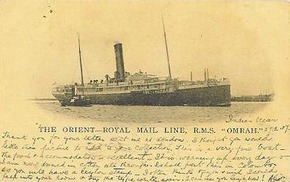
28382
ROBERTS, George Philip (Philp)
| Service Number: | 17062 |
|---|---|
| Enlisted: | Not yet discovered |
| Last Rank: | Sapper |
| Last Unit: | 5th Divisional Signal Company |
| Born: | Adelaide SA, 1893 |
| Home Town: | Adelaide, South Australia |
| Schooling: | Not yet discovered |
| Occupation: | Collar Maker |
| Died: | Natural causes , Spring Bank , 22 August 1965 |
| Cemetery: | Not yet discovered |
| Memorials: |
World War 1 Service
| 19 Jan 1917: | Involvement Sapper, 17062, 5th Divisional Signal Company, --- :embarkation_roll: roll_number: '6' embarkation_place: Adelaide embarkation_ship: RMS Omrah embarkation_ship_number: '' public_note: '' | |
|---|---|---|
| 19 Jan 1917: | Embarked Sapper, 17062, 5th Divisional Signal Company, RMS Omrah, Adelaide | |
| 11 Nov 1918: | Involvement Sapper, 17062 |
Help us honour George Philip (Philp) Roberts's service by contributing information, stories, and images so that they can be preserved for future generations.
Add my storyBiography contributed by St Ignatius' College
Life before the War
George Philip Roberts was born in Adelaide in the year 1893. He was brought up a Catholic and lived at 11 Rosemont Street Norwood. George had dark brown hair and blue eyes and was approximately 165 cm and weighed around 53 kg. This was the average male height for that time period. As a young man, he fell in love with a girl named Kathleen Vargan and they were soon married. George worked as a collar maker in the local area. As far as records show, George and Kathleen did not have any children.
Life in service
George was 23 years and 9 months when he enlisted in The Australian Infantry Force on September 2nd 1916. He embarked on the ship R.M.S Omrah on 19th of January 1917 and disembarked in Plymouth on the 27th March 1917. From here he proceeded to France from the Signal Depot, in Hutchen England on the 18th April 1917. He travelled back and forth from England to France and was discharged from the Australian Infantry Force on the 28th May 1919. He was posted to the Divisional Signal Company and was a level 1 Sapper. This name “Sapper “was used instead of the word “Private”.
During World War 1 the Division Signals Company was part of the Royal Australian Engineers. Later it was named the Royal Australian Signal Corps. The main role of this group was to provide communication from Headquarters to the troops. This was communicated by a telephone line during 1916-1918. They had to lay the line to receive the communication. Homing pigeons, motor cycles and horses were also used to send messages during the war. Field telephone was the most common form of communication. Later on this group used “Power Buzzers” to connect to radio signals. Power Buzzers were audio signalling devices. This often put them in dangerous situations as the enemies could see the aerials in the air and fire at them. For example, for the troops based at Gallipoli, the enemies knew that these aerials were giving information back to headquarters.
After the war
According to the records George Philip Roberts returned to Australia and lived a happy life. There is no information to be found about his life after the war. George died at the age of 72 years on the 22nd of August 1965. He died of natural causes.
Conclusion
George Phillip Roberts was a local South Australian who fought for his country. He left his wife to travel overseas and experience the life of a soldier. He was a member of the Fifth Divisional Signal Corporation and travelled to England and France as a member of this team. He arrived back in Australia uninjured and lived out the rest of his life in Adelaide . He is to be remembered as a unique member of the Australian Infantry Force.












